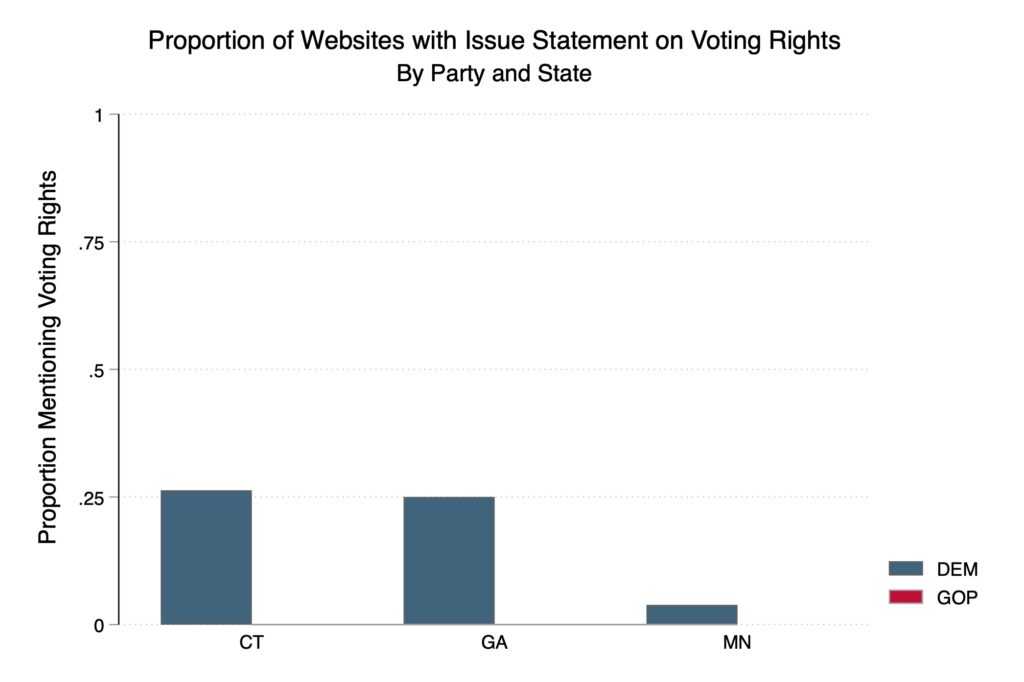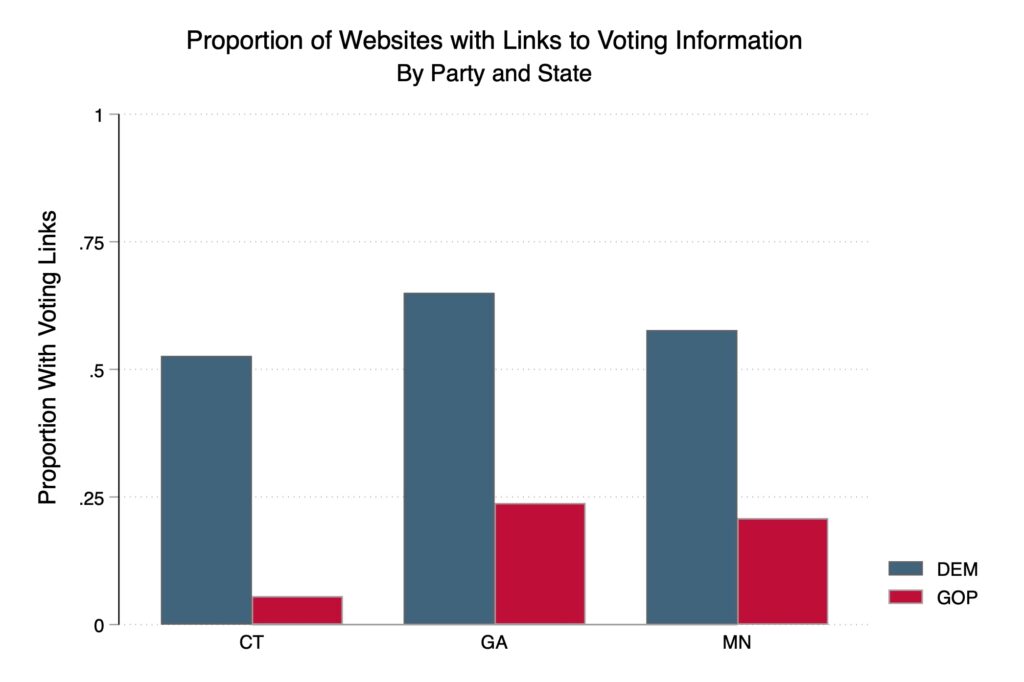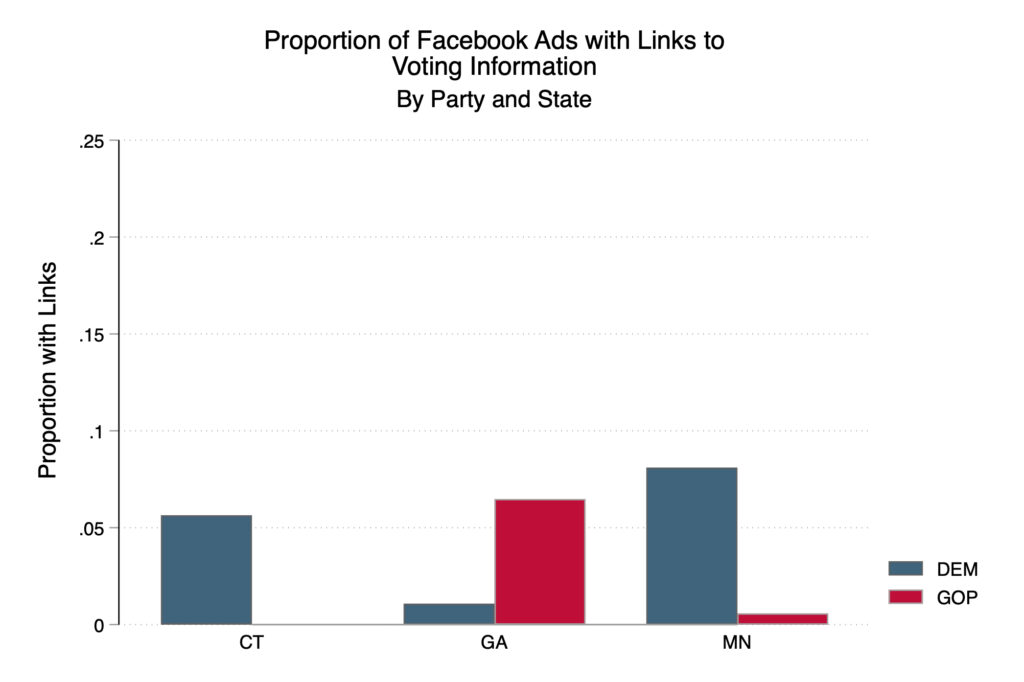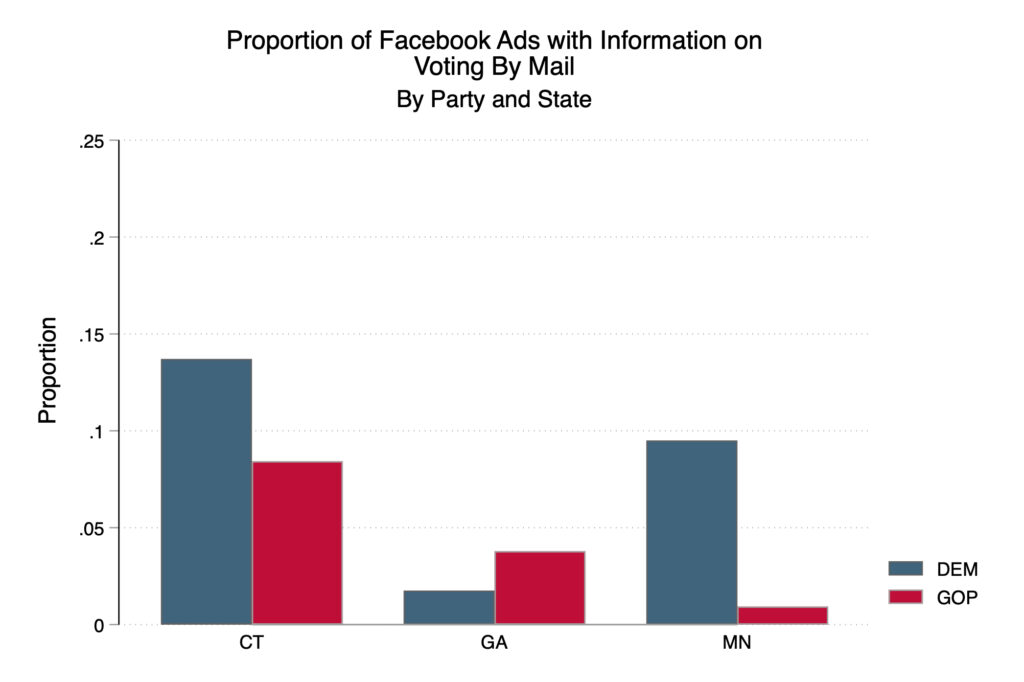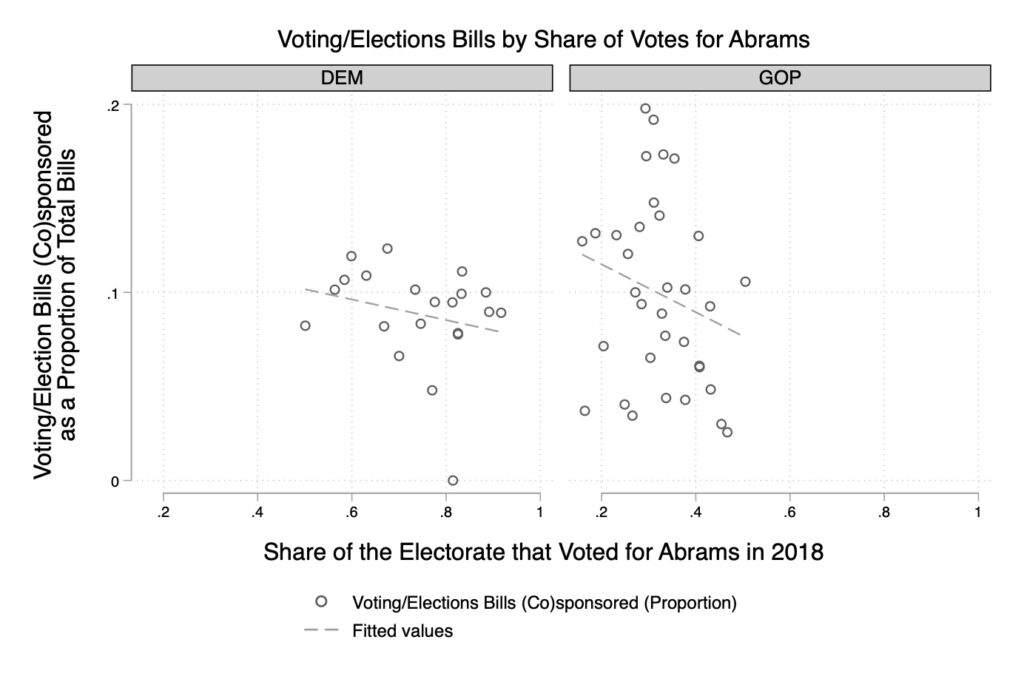By Hannah Landel ’22 and Arianne Philemy ’21
Introduction
Throughout, leading up to, and even after the election, Donald Trump made strong, unfounded accusations of voter fraud and urged people to vote in person. On the other hand, Biden’s campaign encouraged people to vote early and mail in their ballots in order to prevent the spread of COVID-19. This post examines whether the differences observed at the presidential level apply to down ballot races. By examining a sample of State Senate candidates’ websites and Facebook ads for the 2020 elections in Minnesota, Georgia, and Connecticut, we find that Democrats were generally more likely to spend time and money focusing on and providing information on voting rights, how to vote, and voting by mail.
Post 2020 election, the two parties continue to take different stances on voting, this time legislatively. Democrats in Minnesota, Georgia, and Connecticut are pushing for legislation such as no-excuse absentee voting and early voting that would make voting more accessible. On the other hand, Republicans in these states are pushing for legislation that would restrict voting access, such as cutting back on early voting days and restricting who can use absentee ballots. The most prominent example is the recent Georgia law that makes voting more difficult by doing things like limiting drop boxes and making it illegal to give water to voters in line.
We also explore the post-2020 election story with data collected on State Senate bills in the 2021 legislative session of Minnesota, Georgia, and Connecticut. In this post, we focus on Georgia and further demonstrate the partisan nature of voting rights as an issue. We also examine the relationship between competitiveness and partisanship of a district and legislators’ (co)sponsorship of voting rights legislation. We find mixed results for Democrats and Republicans.
Voting Rights and Information on Campaign Websites
Using data collected on the issues mentioned in 128 State Senate candidate websites across Connecticut, Georgia, and Minnesota, we graph both the proportion of candidate websites with an issue statement on voting rights and the proportion of candidate websites with information on how to vote. Candidates that mentioned voting rights in their issue statements focused on specifics like redistricting and expanding absentee voting. Candidates that included information on how to vote sometimes had links to their state’s voting websites or had sections devoted specifically to how to register to vote and where to find the nearest polling location. Starting with Democrats, we find that 26% of the Connecticut Democratic candidates we examined mentioned voting rights in the issue statements on their websites, the most out of the three states. Georgia Democrats were a close second, with about 25% of candidates including an issue statement about voting rights on their website, and Minnesota Democrats were last, with about 4%. It could be that Minnesota Democrats were the least likely of the Democratic candidates in each of the three states to mention voting rights as an issue because the voting rights laws are less restrictive in Minnesota, and thus Democrats perceived there to be less of a need to reform them.
In contrast with Democratic candidates, not a single Republican candidate mentioned voting rights in the issue statements on their websites in either Connecticut, Georgia, or Minnesota.
However, candidates in both parties across all three states included information about how to vote on their websites. Many candidates provided links to official voting websites, while others went into detail about the voting options and how to go about each option. In each state, Democratic candidates did so at higher rates than their Republican counterparts. Out of the three states, Connecticut had the lowest percentage of both Democratic and Republican candidates who posted information about how to vote on their websites, while Georgia had the highest percentage of both Democratic and Republican candidates who did so. Given the heightened focus on increasing voter turnout in Georgia in an effort to tip the election at the national level, it makes sense that these efforts were pushed down-ballot as well.
The difference in the percentage of candidates who included voting rights and those who included information about how to vote on their websites may stem from differences in the motivations for doing so. Candidates likely include information about how to vote on their websites in an effort to increase voter turnout and thus their chances of winning. On the other hand, mentioning voting rights in their issue statements simply signals that voting rights are an important part of the candidate’s platform, but doesn’t help voters know how to vote in the election. Additionally, because the election was fraught with claims of voter fraud that had the potential to keep people from voting, providing information on how to vote may have been seen as especially important.
Voting Rights and Information in Facebook Ads
Using data collected on State Senate candidate Facebook ads across Connecticut, Minnesota, and Georgia, we graph the proportion of Facebook ads that mention voting rights, that have links to voting information, and that have information on voting by mail by state and party. Importantly, because of the way Facebook ads work, instead of looking at the total number of Facebook ads that mention a specific issue, we look at the “estimated spend” of an ad — the amount that ad costs to run. Therefore, the proportion of Facebook ads that mention voting rights, for example, is calculated by adding up the amount spent on ads that mentioned voting rights for all Democratic candidates in Connecticut and then dividing that amount by the amount of money spent on ads overall by Democratic candidates in Connecticut. This process is then repeated for each party, in each state, for each of the variables we graph.
Similar to the website data, Democratic candidates across all three states spent more money on Facebook ads that mentioned voting rights as an issue than their Republican counterparts. Minnesota candidates were again at the bottom of the ladder, with Connecticut candidates in the middle, and Georgia candidates at the top.
Looking at the proportion of Facebook ads with links to voting information, Democratic candidates in Minnesota and Connecticut spent a higher proportion of money on advertisements that included links to voting information than Democratic candidates in Georgia did. Interestingly, while Republican candidates in Minnesota and Connecticut spent a lower proportion of their money on ads that had links to voting information than their Democratic counterparts, this pattern is reversed in Georgia, where Republicans spent a higher proportion of money on ads that had links to voting information than Democrats did. Put another way, the proportion of money spent on ads with links to voting information by Democrats in Georgia was closer to that of Republicans in Minnesota, and the proportion of money spent by Republicans in Georgia was more comparable to that of Democrats in Connecticut.
Lastly, we graph the proportion of Facebook ads that had information on voting by mail by party and state. Compared to ads that mentioned voting rights or that had links to voting information, the proportion of money spent on ads with information on voting by mail was higher. In the context of COVID-19 and wanting to make sure that people were still able to vote while simultaneously staying safe and preventing the spread of the virus, this makes sense.
Democratic candidates in Connecticut and Minnesota again spent a larger proportion of their money on ads that had information on voting by mail than their Republican counterparts. This trend is also again flipped in Georgia, where Republican candidates spent a larger proportion on such ads than Democratic candidates did. This finding is surprising given the partisan rhetoric surrounding vote-by-mail in 2020. Additionally, there’s an inconsistency when comparing this finding to the findings in the website data, where Georgia Republican candidates focused on voting less than their Democratic counterparts. It is not clear why we observe a different pattern in Georgia on these last two measures.
New Voting Law in Georgia Faces Legal Challenges
Taking a step back to think about the website and Facebook ad data together, the general trend is that Democratic candidates spent more time and money focusing on and talking about voting rights, voting information, and voting by mail. The absence of Republican discussion of those topics fits into the wider narrative of the partisan nature of those issues, but this absence becomes more interesting when paired with the amount of post-election attention voting rights have received.
Out of the three states, Georgia’s voting legislation has received the most media attention. On March 25, Governor Brian Kemp signed Senate Bill 202 into law. This bill resulted in major changes to Georgia’s election laws. Among the changes that resulted from the law, there are now limited drop boxes, new restrictions on absentee voting, and it is even illegal for outside groups to offer water to those in line waiting to vote. Although provisions such as banning early voting on Sundays did not pass, certain provisions still primarily affect minorities in Georgia, specifically African Americans. For example, the new law put limitations on mobile voting, which only took place in Fulton County, Georgia, a predominantly Black county. Former gubernatorial candidate and voting rights activist Stacey Abrams called this new law “nothing less than Jim Crow 2.0.” Despite the governor arguing that signing Senate Bill 202 into law was “common sense,” several civil rights and activist groups have taken legal action, arguing that this bill violates provisions of the Constitution and Voting Rights Act.
There are currently several lawsuits filed opposing the new law. New Georgia Project v. Raffensperger, filed by the New Georgia Project, Black Voters Matter Fund, and Rise, Inc. are suing Brad Raffensperger, the Republican Secretary of State, as well as members of the state election board. In Georgia NAACP v. Raffensperger, the Georgia NAACP, the Georgia Coalition for the People’s Agenda, League of Women Voters of Georgia, GALEO Latino Community Development Fund, Common Cause, and the Lower Muskogee Creek Tribe are also suing Raffensperger. In AME Church v. Kemp, the sixth district of the African Methodist Episcopal Church, Georgia Muslim Voter Project, Women Watch Afrika, Latino Community Fund of Georgia, and Delta Sigma Theta Sorority, Inc. also filed a lawsuit against Governor Kemp, Raffensperger, and members of the state election board. In Asian Americans Advancing Justice – Atlanta v. Raffensperger, Asian Americans Advancing Justice – Atlanta challenges the new voting law. In these lawsuits the plaintiffs argue that SB 202 violated the Voting Rights Act and the First, Fourteenth, and Fifteenth Amendments. The arguments range from SB 202 intentionally discriminating against nonwhites to placing an undue burden on the right to vote. A major reason as to why many of these activist groups such as the Georgia NAACP in New Georgia Project v. Raffensperger filed lawsuits was because they felt the voting changes were made because of false claims about voter fraud and that the state is unlikely to demonstrate a compelling reason for why they enacted the law.. Georgia NAACP v. Raffensperger focuses specifically on new absentee ID requirements and the new rule on drop boxes. The plaintiffs argue that this new law is an attempt to “suppress the participation of Black voters and other voters of color.” In addition to focusing on voting suppression of African Americans, AME Church v. Kemp highlights Georgia’s past discrimination with voting laws and argues against the claim of current voter fraud. Asian Americans Advancing Justice – Atlanta v. Raffensperger argues that the law would negatively and disproportionately affect Asian American and Pacific Island voters as well due to higher rates of voting by mail among these groups in 2020.
Parties Split Over Extending Absentee Voting in Connecticut
Connecticut Republicans and Democrats are also split on how to move forward regarding voting reform, although Democrats control both the State House and Senate in Connecticut. The parties were divided over SB 901, which would extend an absentee voting policy that was put in place because of COVID-19. There were clear partisan divisions over the bill, which passed the State Senate on a party-line vote. Republicans argued the extension was an overreach because of the high vaccination rates in the state. Democrats argued that with pandemic being unpredictable, it is best to err on the side of caution.
Clear Partisan Divide in Georgia on Voting Bill Cosponsorship
For a more detailed analysis of partisan divisions over voting reforms, we looked at the sponsorship patterns of voting legislation in Georgia. Using data collected from openstates.org on bills sponsored and cosponsored by state senators in Georgia’s 2021 legislative session, we explore the partisan nature of voting rights legislation as well as the relationship between district vote share for Stacey Abrams in 2018 and (co)sponsorship of current voting rights legislation.
Out of the 49 voting and elections bills sponsored in Georgia, 47 of them (or 95.92%) had only partisan support. Further breaking this down, 30 bills had only Republican cosponsors, 17 bills had only Democratic cosponsors, and the remaining two bipartisan bills were split 86-14% and 44-56% Republican-Democratic support, respectively. Needless to say, voting rights is a very partisan issue, and this fits into the broader context of the national conversation surrounding voting rights. Voting rights is also especially partisan when compared with other issues, like education, where many bills have bipartisan support. In Georgia, for example, bipartisan education bills made up 37% of the total education bills proposed in the 2021 legislative session.
Next, we divide the number of voting rights bills (co)sponsored by the total number of bills (co)sponsored for each legislator. We then graph the proportion of voting bills (co)sponsored against the share of the vote that Stacey Abrams received in each legislator’s district in 2018. The share of the electorate that voted for Abrams in the 2018 Georgia gubernatorial election stands as a measure of district partisanship. By creating two different graphs for Democrats and Republicans, we effectively control for content of the bill, since Democratic bills are more likely to expand voting rights while Republican bills tend to restrict voting rights. Looking at the Republican graph, Republicans from safer Republican districts sponsor a greater percentage of voting bills than Republicans from more competitive districts. Interestingly, the trend is reversed for Democrats; Democrats from safer Democratic districts sponsor a smaller percentage of voting bills than Democrats from more competitive districts. The relationship is not statistically significant for either party, however (p>0.20).
Conclusion
By looking at website data and Facebook ad data from State Senate campaigns for the 2020 election as well as at legislation introduced post-election, both qualitatively and quantitatively, it is clear that Democrats and Republicans in Minnesota, Georgia, and Connecticut have taken very different stances. Democrats remain committed to expanding voting rights and were more likely to include voting rights both in the issue statements on their candidate websites and in Facebook ads. Democrats were also more likely to provide information on voting. On the other hand, though Republicans did include information on voting (overall and by mail) on both their candidate websites and in Facebook ads, they did so to a lesser degree than Democrats. Additionally, while Republicans shied away from mentioning voting rights in their campaigns, they now seem fixated on the issue. There’s a particular focus on voting rights in Georgia, as Republicans just passed Senate Bill 202, which civil rights groups have said restricts the voting rights of many voters, particularly black voters. Looking at both the national conversation and the bills data, it is clear that voting rights are a very partisan issue. Going forward, in the wake of both the COVID-19 pandemic and the rise of social justice movements, and the drastically different opinions on those issues from the two parties, it is clear that bipartisan support moving forward is becoming less and less likely.
